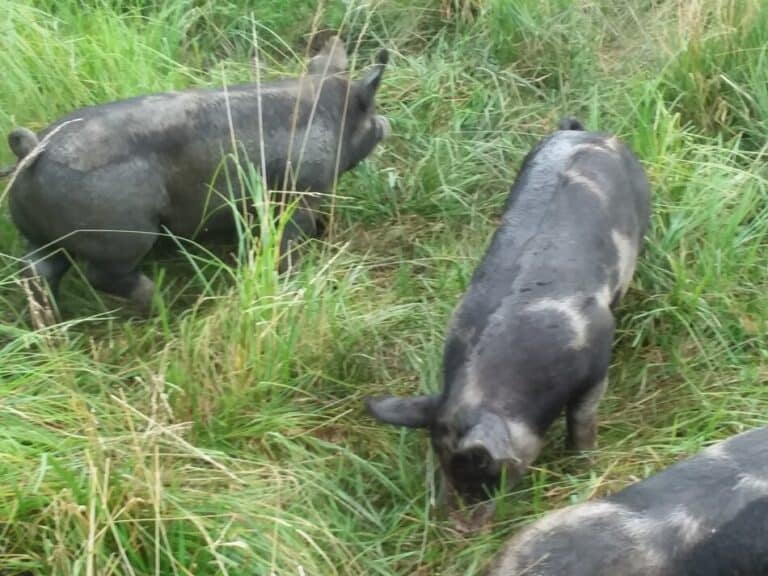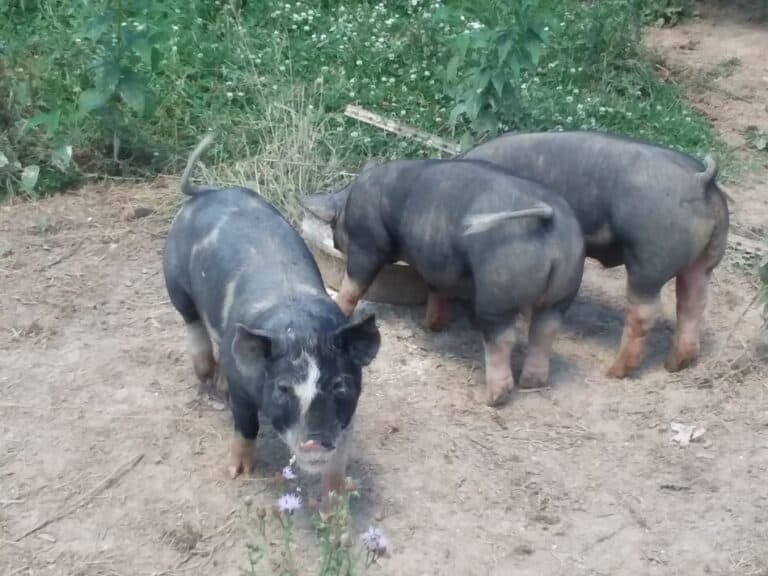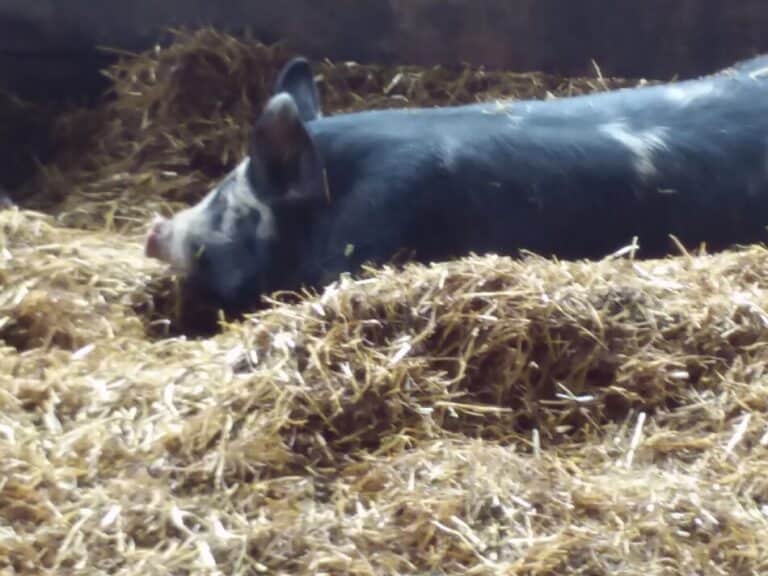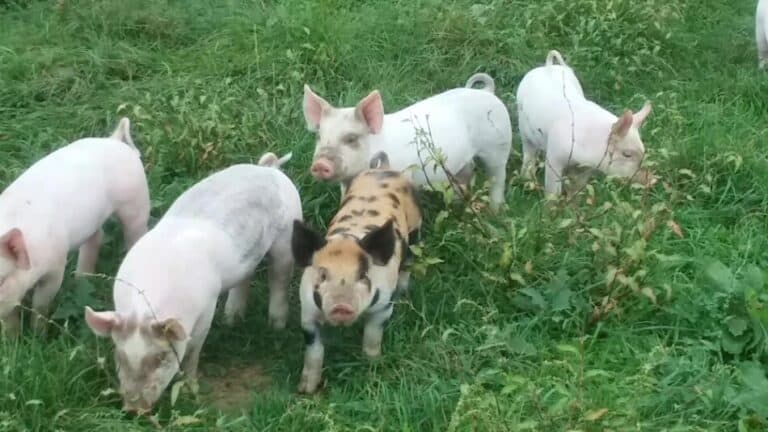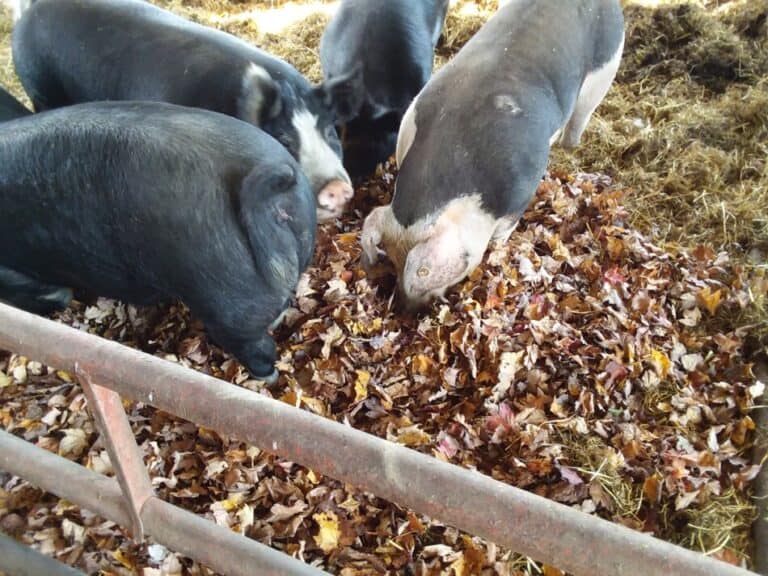Why Do Farmers Have Pigs?
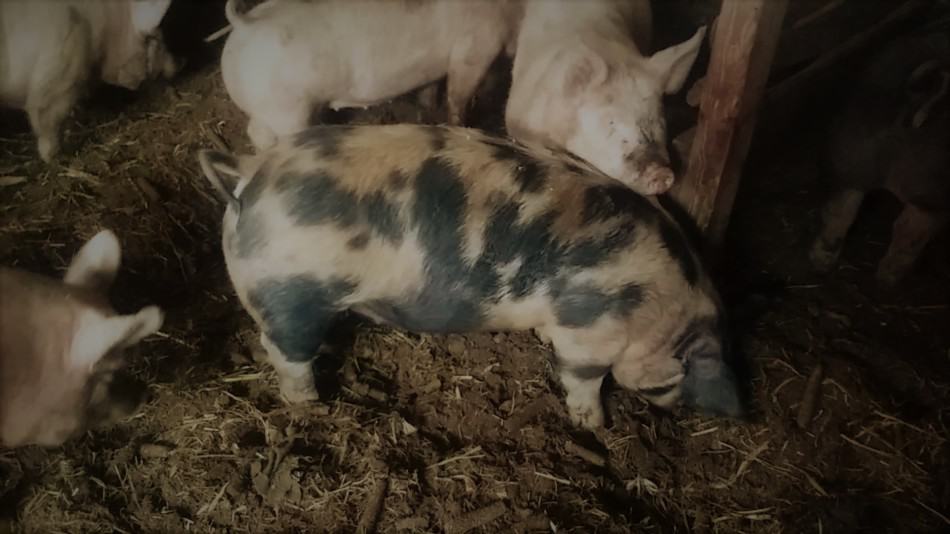
Small farms and large farms alike raise pigs. Now pigs are becoming more popular with hobby farmers, as well. With all of the options of different animals to raise, why do farmers choose to raise pigs?
Most farmers raise pigs for income. Pigs convert locally available resources, like grain, forages or food waste, into meat, allowing the farmer to make money by selling feeder pigs (weaned piglets), market hogs, and/or breeding stock.
Is Raising A Pig For Meat Worth It? is an article I wrote to help you figure out your budget for raising a few pigs for the freezer.
Pigs are raised by farmers for farm income
Most farmers are raising pigs as a partial or main income enterprise. Some farmers exclusively raise pigs others have multiple species of livestock, including pigs.
These days, a pig farm is more commonly thought of as an industrial agriculture confinement operation, with all of the pigs in big buildings, but that’s not always the case.
Increasingly, small farmers are getting into the pig game, as well.
Pros And Cons Of Raising Pigs gives you the good and the not so good of getting into pigs!
Pig farms can be of any size, from very small to huge
Just having one sow that you sell piglets from could be your pig operation, up to many sows and tons of piglets!
Or a farmer could buy feeder pigs, pigs that are born at someone else’s house and are now weaned, and raise them up for customers or the finished pig market.
This farmer would feed pigs, but not have any newborn piglets, just feeders.
Pigs can provide a nice income for small farmers
Plenty of folks buy feeder pigs, raise them up to full size and sell the meat as retail cuts, whole hogs or half hogs to customers.
This would make a nice side income for a small farmer that loves to work with people.
To make custom raised pigs a full time enterprise, it would have to be sizable and probably put with other meats, but that’s doable, as well.
In our area, raising show pigs is popular. Most folks who raise show pigs are part time with their pig endeavors, but are still getting a nice income from a litter of show quality piglets.
We raise pigs, I have a small herd that I am building up. I sell feeder pigs at the local auction and raise a few market hogs for ourselves.
Pigs are a small part of our farm income but since they take different things than our other enterprises, sheep and garlic, the pigs fit into the farm well and can use the excesses of the other parts of the farm and turn it into meat.
When Should You Sell Your Pigs? helps you determine the selling size and condition that makes the most sense for your area.
For example, we feed out lambs for the winter in the barn.
When I put pigs in this area to clean out the pens, they root around and turn the bedding into compost, which makes cleaning out the pen much easier.
Plus it puts the pigs to work doing something that they are great at, rooting around for snacks!
Hobby farmers can raise pigs for enjoyment
It is becoming more popular for folks to raise pigs for fun or enjoyment, rather than pig being raised mainly for the money.
These pigs would bring in some money, but generally, not enough to replace a full time job.
I call these folks hobby farmers, meaning they are selling some animals but most of the farm is not exclusively for profit, it’s for enjoyment.
Being a hobby farmer, even on a very small scale, is hugely popular around here!
Hobby farmers are doing wonderful work with rare breeds of pigs, like Large Black, that need folks to raise them to keep the population levels up.
Check out Triangle K Ranch, here in Ohio, that raises Large Black hogs. Triangle K Ranch is working to promote and conserve the Large Black Hogs, selling breeding stock and meat to spread the word about their favorite breed!
Pigs turn available resources into meat
Pigs are omnivores, meaning they can eat a diet very similar to ours. Pigs can turn nearly any feed into meat, including grain, vegetable waste, forages, insects and most anything else you can think of.
Got fallen apples in your orchard? Turn in the pigs. Have extra produce that didn’t sell or is damaged? Give it to the pigs. Don’t need your fall pumpkins anymore? Give them to the porkers, they really love pumpkins and winter squash!
Bigger pigs can eat more of their diet as alternative foods
Sows, adult female pigs that are the moms of the group, can eat forages for up to 50% of their diet. This means that if the farmer has extra pasture area, the pigs can put it to good use.
This is a pretty big deal, since the biggest cost of having livestock is feed costs. Getting the sows to find half of their own feed can really save on feed costs for the small farmer.
Interestingly enough, not all pig farmers feed grain. Check out Sugar Mountain Farm, a pig farm in Vermont that uses pasture and other feeds like pumpkins and sunflowers to feed the pig herd.
Sugar Mountain is a great example of the versatility of pigs. They don’t feed grain because it is too expensive to get it shipped to their farm, so they feed things available in the area, like cheese trimmings and whey.
Another example of pigs using available resources and turning it into food would be a produce farm or a community garden.
Think of all of the extra or damaged produce they would have to feed pigs! Sure the pigs would still need pig feed, but not as much as they would with the vegetables they are eating.
Pigs need a smaller space to live than other animals
In areas where land use is restricted, due to small acreage sizes or other constraints, pigs can be used to raise a significant amount of meat on a smaller amount of land or in a smaller building.
The fact that pigs can be raised on smaller amounts of land is a big deal to anyone wanting to raise livestock, yet limited on how much area the pigs can be on.
Sometimes limited land availability is due to not owning the land, but also it can be due to severe predation potential or trying to limit parasite exposure.
Unlike ruminants (cattle, sheep, goats), which require more land to get their fill of grasses, forbs and other forages, omnivores like pigs can eat higher calorie foods so they need less area to roam.
Pigs do not have to be under roof, they love to be out on the land, but it’s not always feasible for the farmer or the area.
Pig poop is a great fertilizer
Emma Naluyima, a veterinarian and pig farmer in Uganda, uses her pigs to provide the fertilizer for the rest of her one acre farm. The link is to an article that explains her whole operation, including pictures. Definitely worth a good look!
Of course, any pig farmer can and should use pig poop as a fertilizer, but Emma is the first person I’ve heard talk about the wonders of pig dung with such enthusiasm!
Pigs can be used to renovate overgrown areas
Using pigs as a renovation tool is becoming more of a common practice, especially with folks keeping pigs on pasture.
Pigs can eat and knock down the under brush type growth, like briars, that can easily start to take over a wooded area, making it no longer suitable for grazing or walking.
